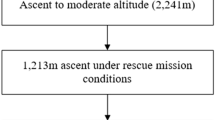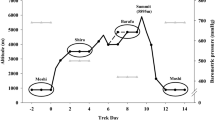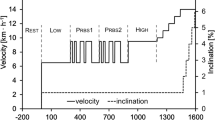Abstract
Purpose
Both prolonged exercise and acute high-altitude exposure are known to induce cardiac changes. We sought to describe the cardiac responses to speed climbing at high-altitude, including left ventricular (LV) performance assessment using the myocardial work index (MWI), a new index derived from 2D speckle tracking echocardiography (STE).
Methods
Eleven elite alpinists (9 males, age: 26 ± 4 years) were evaluated before and immediately after a speed ascent of the Mont-Blanc (4808 m) by echocardiography using conventional measurements as well as STE and MWI computation with derivate parameters as global work efficiency (GWE) or global wasted work (GWW).
Results
Athletes performed a long-duration (8 h 58 min ± 60 min) and intense (78 ± 4% of maximal heart rate) ascent under gradual hypoxic conditions (minimal SpO2 at 4808 m: 71 ± 4%). Hypoxic exercise-induced cardiac fatigue was observed post-ascent with a change in right ventricular (RV) and LV systolic function (RV fractional area change: – 20 ± 23%, p = 0.01; LV global longitudinal strain change: – 8 ± 9%, p = 0.02), as well as LV geometry and RV–LV interaction alterations with emergence of a D-shape septum in 5/11 (46%) participants associated with RV pressure overload (mean pulmonary arterial pressure change: + 55 ± 20%, p < 0.001). Both MWI and GWE were reduced post-ascent (– 21 ± 16%, p = 0.004 and – 4 ± 4%, p = 0.007, respectively). Relative decrease in MWI and GWE were inversely correlated with increase in GWW (r = – 0.86, p = 0.003 and r = -0.97, p < 0.001, respectively).
Conclusions
Prolonged high-altitude speed climbing in elite climbers is associated with RV and LV function changes with a major interaction alteration. MWI, assessing the myocardial performance, could be a new tool for evaluating LV exercise-induced cardiac fatigue.




Similar content being viewed by others
Availability of data and materials
The datasets generated during and/or analyzed during the current study are available from the corresponding author on reasonable request.
Code availability
Not applicable.
Abbreviations
- ABP:
-
Arterial blood pressure
- AMS:
-
Acute mountain sickness
- ANOVA:
-
Analysis of variance
- BM:
-
Body mass
- GCW:
-
Global constructive work
- GLS:
-
Global longitudinal strain
- GWE:
-
Global work efficiency
- GWW:
-
Global wasted work
- [Hb]:
-
Hemoglobin concentration
- Hct:
-
Hematocrit
- HR:
-
Heart rate
- HRmax :
-
Maximal heart rate
- LV:
-
Left ventricle
- LVED:
-
Left ventricle end-diastolic
- LVEF:
-
Left ventricle ejection fraction
- LVEI:
-
Left ventricle end-systolic eccentricity index
- LLQ:
-
Lake Louise questionnaire
- mPAP:
-
Mean pulmonary artery pressure
- MWI:
-
Myocardial work index
- PEH:
-
Postexercise hypotension
- PV:
-
Plasma volume
- RPE:
-
Rating of perceived exertion
- RV:
-
Right ventricle
- RV FAC:
-
Right ventricle fractional area change
- SD:
-
Standard deviation
- SV:
-
Stroke volume
- sPAP:
-
Systolic pulmonary artery pressure
- SpO2 :
-
Pulse oxygen saturation
- STE:
-
Speckle tracking echocardiography
- TTE:
-
Transthoracic echocardiography
- \(\dot{\mathrm{V}}{\mathrm{O}}_{2\mathrm{peak}}\) :
-
Peak oxygen uptake
References
Allemann Y, Rotter M, Hutter D et al (2004) Impact of acute hypoxic pulmonary hypertension on LV diastolic function in healthy mountaineers at high altitude. Am J Physiol-Heart Circ Physiol 286:H856–H862. https://doi.org/10.1152/ajpheart.00518.2003
Bernardi L (2006) Hypoxic ventilatory response in successful extreme altitude climbers. Eur Respir J 27:165–171. https://doi.org/10.1183/09031936.06.00015805
Billat VL, Dupré M, Karp JR, Koralsztein JP (2010) Mountaineering experience decreases the net oxygen cost of climbing Mont Blanc (4808 m). Eur J Appl Physiol 108:1209–1216. https://doi.org/10.1007/s00421-009-1334-9
Boe E, Skulstad H, Smiseth OA (2019) Myocardial work by echocardiography: a novel method ready for clinical testing. Eur Heart J - Cardiovasc Imaging 20:18–20. https://doi.org/10.1093/ehjci/jey156
Boos CJ, Mellor A, Begley J et al (2014) The effects of exercise at high altitude on high-sensitivity cardiac troponin release and associated biventricular cardiac function. Clin Res Cardiol 103:291–299. https://doi.org/10.1007/s00392-013-0654-2
Champigneulle B, Davranche K, Brugniaux JV et al (2022) Efect of a speed ascent to the top of Europe on cognitive function in elite climbers. Eur J Appl Physiol. https://doi.org/10.1007/s00421-021-04855-6
Chan J, Edwards NFA, Khandheria BK et al (2019) A new approach to assess myocardial work by non-invasive left ventricular pressure–strain relations in hypertension and dilated cardiomyopathy. Eur Heart J - Cardiovasc Imaging 20:31–39. https://doi.org/10.1093/ehjci/jey131
Chemla D, Castelain V, Humbert M et al (2004) New formula for predicting mean pulmonary artery pressure using systolic pulmonary artery pressure. Chest 126:1313–1317. https://doi.org/10.1378/chest.126.4.1313
Cikes M, Solomon SD (2016) Beyond ejection fraction: an integrative approach for assessment of cardiac structure and function in heart failure. Eur Heart J 37:1642–1650. https://doi.org/10.1093/eurheartj/ehv510
D’Andrea A, Radmilovic J, Carbone A et al (2020) Speckle tracking evaluation in endurance athletes: the “optimal” myocardial work. Int J Cardiovasc Imaging. https://doi.org/10.1007/s10554-020-01871-z
Dalla Vecchia L, Traversi E, Porta A et al (2014) On site assessment of cardiac function and neural regulation in amateur half marathon runners. Open Heart 1:e000005. https://doi.org/10.1136/openhrt-2013-000005
Dávila-Román VG, Guest TM, Tuteur PG et al (1997) Transient right but not left ventricular dysfunction after strenuous exercise at high altitude. J Am Coll Cardiol 30:468–473. https://doi.org/10.1016/S0735-1097(97)00179-4
De Boeck BW, Toma A, Kiencke S et al (2018) Altered left ventricular geometry and torsional mechanics in high altitude-induced pulmonary hypertension: a three-dimensional echocardiographic study. J Am Soc Echocardiogr 31:314–322. https://doi.org/10.1016/j.echo.2017.12.001
Dill DB, Costill DL (1974) Calculation of percentage changes in volumes of blood, plasma, and red cells in dehydration. J Appl Physiol 37:247–248. https://doi.org/10.1152/jappl.1974.37.2.247
Duc S, Cassirame J, Durand F (2011) Physiology of ski mountaineering racing. Int J Sports Med 32:856–863. https://doi.org/10.1055/s-0031-1279721
Elliott AD, La Gerche A (2015) The right ventricle following prolonged endurance exercise: are we overlooking the more important side of the heart? A meta-analysis. Br J Sports Med 49:724–729. https://doi.org/10.1136/bjsports-2014-093895
Fornasiero A, Savoldelli A, Fruet D et al (2018) Physiological intensity profile, exercise load and performance predictors of a 65-km mountain ultra-marathon. J Sports Sci 36:1287–1295. https://doi.org/10.1080/02640414.2017.1374707
Fornasiero A, Zignoli A, Rakobowchuk M et al (2021) Post-exercise cardiac autonomic and cardiovascular responses to heart rate-matched and work rate-matched hypoxic exercise. Eur J Appl Physiol 121:2061–2076. https://doi.org/10.1007/s00421-021-04678-5
Forsythe L, George K, Oxborough D (2018) Speckle tracking echocardiography for the assessment of the athlete’s heart: is it ready for daily practice? Curr Treat Options Cardiovasc Med 20:83. https://doi.org/10.1007/s11936-018-0677-0
Hackett PH, Roach RC (2001) High-altitude illness. N Engl J Med 345:107–114. https://doi.org/10.1056/NEJM200107123450206
Halliwill JR, Buck TM, Lacewell AN, Romero SA (2013) Postexercise hypotension and sustained postexercise vasodilatation: what happens after we exercise? Exp Physiol 98:7–18. https://doi.org/10.1113/expphysiol.2011.058065
Hubert A, Le Rolle V, Leclercq C et al (2018) Estimation of myocardial work from pressure–strain loops analysis: an experimental evaluation. Eur Heart J - Cardiovasc Imaging 19:1372–1379. https://doi.org/10.1093/ehjci/jey024
Keogh E, Chakrabarti K, Pazzani M, Mehrotra S (2001) Dimensionality reduction for fast similarity search in large time series databases. Knowl Inf Syst 3:263–286. https://doi.org/10.1007/PL00011669
La Gerche A, Heidbüchel H, Burns AT et al (2011) Disproportionate exercise load and remodeling of the athlete’s right ventricle. Med Sci Sports Exerc 43:974–981. https://doi.org/10.1249/MSS.0b013e31820607a3
Lang RM, Badano LP, Mor-Avi V et al (2015) Recommendations for cardiac chamber quantification by echocardiography in adults: an update from the American society of echocardiography and the European association of cardiovascular imaging. Eur Heart J - Cardiovasc Imaging 16:233–271. https://doi.org/10.1093/ehjci/jev014
Lord RN, Utomi V, Oxborough DL et al (2018) Left ventricular function and mechanics following prolonged endurance exercise: an update and meta-analysis with insights from novel techniques. Eur J Appl Physiol 118:1291–1299. https://doi.org/10.1007/s00421-018-3906-z
Manganaro R, Marchetta S, Dulgheru R et al (2020) Correlation between non-invasive myocardial work indices and main parameters of systolic and diastolic function: results from the EACVI NORRE study. Eur Heart J - Cardiovasc Imaging 21:533–541. https://doi.org/10.1093/ehjci/jez203
Maufrais C, Rupp T, Bouzat P et al (2017) Heart mechanics at high altitude: 6 days on the top of Europe. Eur Heart J - Cardiovasc Imaging 18:1369–1377. https://doi.org/10.1093/ehjci/jew286
Maufrais C, Rupp T, Bouzat P et al (2019) Medex 2015: the key role of cardiac mechanics to maintain biventricular function at high altitude. Exp Physiol 104:667–676. https://doi.org/10.1113/EP087350
Millet GP, Jornet K (2019) On top to the top—acclimatization strategy for the “fastest known time” to Mount Everest. Int J Sports Physiol Perform 14:1438–1441. https://doi.org/10.1123/ijspp.2018-0931
Mourot L (2018) Limitation of maximal heart rate in hypoxia: mechanisms and clinical importance. Front Physiol 9:972. https://doi.org/10.3389/fphys.2018.00972
Naeije R (2010) Physiological adaptation of the cardiovascular system to high altitude. Prog Cardiovasc Dis 52:456–466. https://doi.org/10.1016/j.pcad.2010.03.004
Nagueh SF, Smiseth OA, Appleton CP et al (2016) Recommendations for the evaluation of left ventricular diastolic function by echocardiography: an update from the American society of echocardiography and the European association of cardiovascular imaging. Eur Heart J - Cardiovasc Imaging 17:1321–1360. https://doi.org/10.1093/ehjci/jew082
Neumayr G (2004) Effect of ultramarathon cycling on the heart rate in elite cyclists. Br J Sports Med 38:55–59. https://doi.org/10.1136/bjsm.2002.003707
Pinsky MR (2020) Dynamic right and left ventricular interactions in the pig. Exp Physiol 105:1293–1315. https://doi.org/10.1113/EP088550
Puthon L, Bouzat P, Rupp T et al (2016) Physiological characteristics of elite high-altitude climbers: climbers in hypoxia. Scand J Med Sci Sports 26:1052–1059. https://doi.org/10.1111/sms.12547
Roach RC, Hackett PH, Oelz O et al (2018) The 2018 lake Louise acute mountain sickness score. High Alt Med Biol 19:4–6. https://doi.org/10.1089/ham.2017.0164
Robach P, Boisson R-C, Vincent L et al (2014) Hemolysis induced by an extreme mountain ultra-marathon is not associated with a decrease in total red blood cell volume. Scand J Med Sci Sports 24:18–27. https://doi.org/10.1111/j.1600-0838.2012.01481.x
Rudski LG, Lai WW, Afilalo J et al (2010) Guidelines for the echocardiographic assessment of the right heart in adults: a report from the American society of echocardiography. J Am Soc Echocardiogr 23:685–713. https://doi.org/10.1016/j.echo.2010.05.010
Rupp T, Jubeau M, Millet GY et al (2013) The effect of hypoxemia and exercise on acute mountain sickness symptoms. J Appl Physiol 114:180–185. https://doi.org/10.1152/japplphysiol.00769.2012
Russell K, Eriksen M, Aaberge L et al (2012) A novel clinical method for quantification of regional left ventricular pressure–strain loop area: a non-invasive index of myocardial work. Eur Heart J 33:724–733. https://doi.org/10.1093/eurheartj/ehs016
Sengupta S, Jain R, Burkule N et al (2020) Myocardial work index: a novel method for assessment of myocardial function in South Asian recreational athletes. J Patient-Cent Res Rev 7:147–156. https://doi.org/10.17294/2330-0698.1730
Siebenmann C, Robach P, Lundby C (2017) Regulation of blood volume in lowlanders exposed to high altitude. J Appl Physiol 123:957–966. https://doi.org/10.1152/japplphysiol.00118.2017
Simpson LL, Steinback CD, Stembridge M, Moore JP (2021) A sympathetic view of blood pressure control at high altitude: new insights from microneurographic studies. Exp Physiol 106:377–384. https://doi.org/10.1113/EP089194
Smiseth OA, Torp H, Opdahl A et al (2016) Myocardial strain imaging: how useful is it in clinical decision making? Eur Heart J 37:1196–1207. https://doi.org/10.1093/eurheartj/ehv529
Sörensen J, Harms HJ, Aalen JM et al (2020) Myocardial efficiency: a fundamental physiological concept on the verge of clinical impact. JACC Cardiovasc Imaging 13:1564–1576. https://doi.org/10.1016/j.jcmg.2019.08.030
Stembridge M, Ainslie PN, Hughes MG et al (2015) Impaired myocardial function does not explain reduced left ventricular filling and stroke volume at rest or during exercise at high altitude. J Appl Physiol 119:1219–1227. https://doi.org/10.1152/japplphysiol.00995.2014
Tadic M, Cuspidi C, Pencic B et al (2021) Association between myocardial work and functional capacity in patients with arterial hypertension: an echocardiographic study. Blood Press 30:188–195. https://doi.org/10.1080/08037051.2021.1902267
Tokodi M, Oláh A, Fábián A et al (2021) Novel insights into the athlete’s heart: is myocardial work the new champion of systolic function? Eur Heart J Cardiovasc Imaging. https://doi.org/10.1093/ehjci/jeab162
Williams N (2017) The Borg rating of perceived exertion (RPE) scale. Occup Med 67:404–405. https://doi.org/10.1093/occmed/kqx063
Acknowledgements
We thank the elite-climbers of the FFCAM and their supervisors for their enthusiastic participation, as well as the staff of the Goûter hut for technical assistance, Julia Roger-Veyer (RN) for expert technical assistance and the Centre national de la recherche scientifique (CNRS) délégation Alpes, for the provision of the Vallot Observatory. Two climbers from the Groupe Excellence National Alpinisme (GEAN), who participated in the study, accidentally passed away during the first ascent of the West face of the Mingbo Eiger (6070m) in Nepal, during collation of this manuscript. The authors express their sincere condolences to the climbers’ families and friends.
Funding
This study was supported by a grant from the FFCAM (Fédération Française des Clubs Alpins et de Montagne). However, the sponsor had no further involvement in any step of the project.
Author information
Authors and Affiliations
Contributions
BC, SD, SB, JVB, PR, PB and SV designed the study and acquired the data. BC and SD performed the statistical analysis. BC, SD, SB and SV analyzed and interpreted the data. BC, SD and SV wrote the manuscript; PB, PR, JVB and SB revised it critically for important intellectual content. All authors gave final approval and agreed to be accountable for all aspects of work ensuring integrity and accuracy.
Corresponding author
Ethics declarations
Conflict of interest
The authors have no conflicts of interest to declare that are relevant to the content of this article.
Ethical approval
This study was performed in line with the principles of the Declaration of Helsinki. Approval was granted by the French Ethics Committee CPP Ouest VI (approval reference number 2019-A01866-51).
Consent to participate
Written informed consent was obtained from all individual participants included in the study.
Consent to publication
The authors affirm that human research participants provided informed consent for publication.
Additional information
Communicated by Massimo Pagani.
Publisher's Note
Springer Nature remains neutral with regard to jurisdictional claims in published maps and institutional affiliations.
Supplementary Information
Below is the link to the electronic supplementary material.
Supplementary file1 (MP4 16087 KB)
Rights and permissions
About this article
Cite this article
Champigneulle, B., Doutreleau, S., Baillieul, S. et al. Changes in cardiac function following a speed ascent to the top of Europe at 4808 m. Eur J Appl Physiol 122, 889–902 (2022). https://doi.org/10.1007/s00421-022-04895-6
Received:
Accepted:
Published:
Issue Date:
DOI: https://doi.org/10.1007/s00421-022-04895-6




